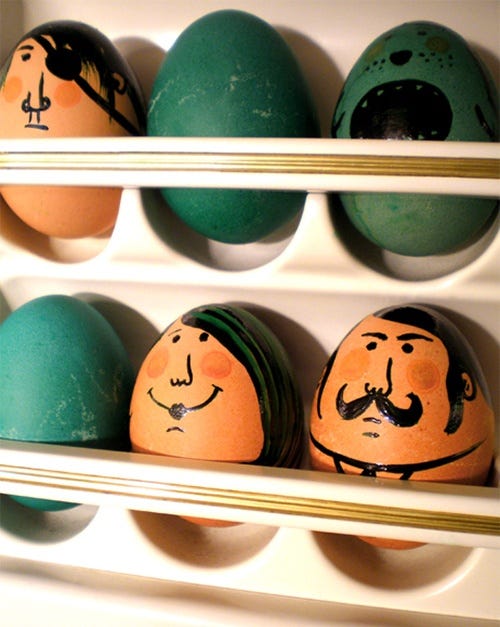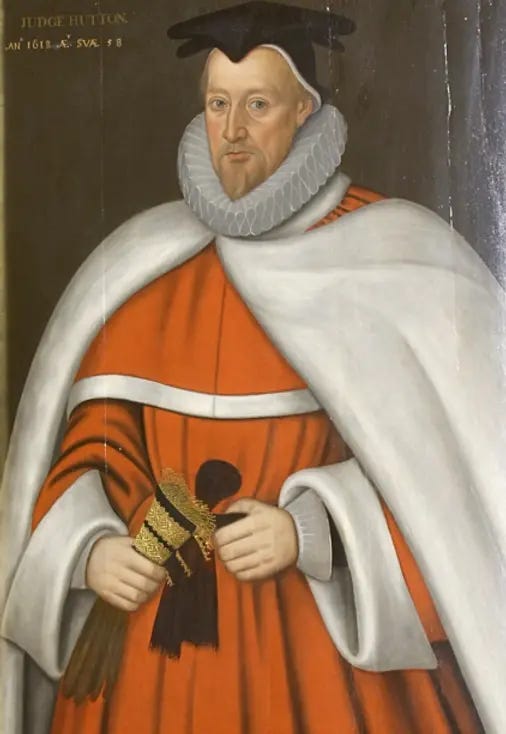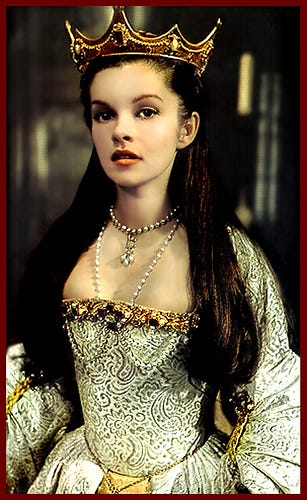Wolf Crawl, Weeks 12 and 13: The Headwear of "Anna Regina"
Coronets, caps, and chickens' eggs abound.
”Anna Regina” is chock full of intriguing bits of headwear, starting right off the bat with Helen Barre’s sweet children. Seeking safety and security in the wake of Helen’s abusive husband’s disappearance and the less-than-generous treatment they’ve received from local nuns, Helen and her family have come to Austin Friars. The little ones, with their “caps and dimpled faces” (419), are already learning their colors and 1-2-3. We shall see much more of Mistress Barre, with or without headgear.
As the chapter goes on, it is the removal of head covering that next catches our attention:
Henry takes off his embroidered cap, throws it down, runs his hands through his hair. Like Wyatt’s golden mane, his hair is thinning, and it exposes the shape of his massive skull. (445)
[Side note, “Wolf Hall: The Mirror and the Light” has finally begun airing on PBS in the States, and I am over the MOON!]
Henry’s jeweled cap was likely similar to what we see in this screenshot from the second series of “Wolf Hall.” As we’ve previously learned, men’s caps were also sometimes known as bonnets, and Henry’s would have been made with conspicuous jewels and sumptuous fabrics. Henry, the conspicuously red-headed royal, is beginning to show the inevitable signs of aging. This is a difficult prospect for the perpetually young-at-heart king. The reality of losing his hair, a longtime symbol of one’s virility and power, likely gives Henry pause.

Admittedly, I know little about 16th century Easter observance in England, other than the theological and scriptural roots of the celebration from my own faith background. I understood that Henry and Anne’s Easter feasts would not, for example, include the Easter Bunny, but until Wolf Hall, I had no idea that their observance would include Easter eggs.
The Easter eggs, he sees, bear his own unmistakeable features. Jo has painted his hat and his hair in one, so he seems to be wearing a cap with ear-flaps. (446)
I did a little research into Tudor Lenten observance and Easter celebrations:
On Good Friday, the faithful might participate in “Creeping to the Cross,” a ceremony in which clergymen would approach the crucifix on their hands and knees before kissing the feet of Christ. (Perhaps the origin of one of Norfolk’s unholy oaths, “by the blood of creeping Christ”?)
Even Henry VIII would creep to the cross and retain a number of Catholic traditions, burying the cross to commemorate Jesus entering the tomb, and returning shoeless to the foot of the cross on Easter Sunday. This was a bit of a bummer to his decidedly Evangelical Archbishop of Canterbury, Thomas Cranmer (see the 1537 letter to Cromwell in which he bemoans such practices).
Similar to today, Easter would mark the end of Lenten dietary observances, although the Tudors’ were more restrictive than modern ones. All dairy and meat would return to the diet, including the Cromwell household’s much-loved painted eggs.
My favorite quick reference to headgear is in a conversation between Cromwell and one of my favorite characters in the entire trilogy, Christophe. The young Frenchman has just offered to essentially “off” Uncle Norfolk (or “Uncle Norferk,” as Christophe calls him) for his new master, Thomas Cromwell.
No, Christophe, I need you to stop the rain spoiling my hats. (450)
Lawyers like Cromwell might wear simple linen coifs under their hats with a tie under the chin, similar to those worn by doctors, the elderly, and young children. They were sometimes known as biggins, from the French beguin [bonnet]. Interestingly, courtroom caps or hats were structured pieces worn atop the coif and might have been made of black velvet, as we see in the portrait of Sir Richard Hutton below, until Elizabeth passed the 1557 Sumptuary Laws.


A number of the headgear references in “Anna Regina” pertain to the eponymous queen-to-be, Anne Boleyn. During coronation ceremonies, she wears her long hair “loose beneat a circle of gems” (463).
…and resting the crown of St. Edward briefly on her head, before changing for a lighter and more bearable crown: a prestidigitation, [Cranmer’s] hands as supple as if he’d been shuffling crowns all his life. (467)
This image is remarkable to me. It hearkens back to Cromwell’s observance of Wolsey during the moment of transubstantiation at Mass, when he smoothly changes bread & wine into Christ’s body and blood as quickly as he might perform any other perfunctory gesture. In this new age, when England is leaving Catholicism behind, the prestidigitation is no longer changing a thin wafer into the body of Christ or a chalice of wine into God’s blood, but rather a legendary crown into a simpler one and a gentlewoman into a queen.
(One can, of course, learn more about current and past English crowns via Historic Royal Palaces.)
At the chapter’s conclusion, a very-pregnant Anne departs for Windsor to begin her confinent, outfitted as the queen she has now become:
She is very pale, very grand, a tiny jewelled head balanced on the swaying tent of her body….” (483).
At this precipitous moment, Anne’s headgear is as refined, feline, and precarious as she is.
The final references come from the story’s return to Helen Barre. Cromwell is whisking her away to serve Grete, Cranmer’s secret wife, who is heavily pregnant and very much alone. First, Cromwell imagines Grete roaming the streets of London during the coronation, an anonymous woman like any other:

The protection of the stranger in the city; one young woman in a cheerful cap and gown, one pair of eyes among the thousands of eyes: you can hide a tree in a forest. (475-476)
And Helen, efficient and determined, rises to the occasion with an instant readiness that Cromwell wishes the men in his service had:
…Helen appears. She is fastening her hair under a clean cap. (477)
We’ll find out why Helen wasn’t wearing her cap later. [Insert winking emoji.] But I do love that the chapter begins and nearly ends with images of the Barre family members in their simple caps.
Our story takes place in a time of great pomp and high fashion: Rich crimson fabrics, priced by the yard; handcrafted lace on liturgical vestments; jeweled pins that poke foolish young men in the fingertips; and bright green silken hosiery, running past us and catching our eyes. But Helen and her children come to us without pretense, and their headgear reflects this.
We also see two very different images of pregnancy: Anne’s jeweled head enters confinement in a royal palace, while Grete asks for a single candle and pushes her belly over the edge of the worn wooden table.
Maybe these contrasts are metaphoric: This is, after all, the period when Cromwell guides his king and his nation through the transition from ostentatious popery to sola scriptura, from jewel-encrusted tombs to unadorned wooden crosses.
But maybe it’s just good writing: sharp, precise characterization from a master of the craft.
Yours in painted eggs and circles of gems,
Analise





Wonderful, thank you. And for pointing out the two pregnancies contrasted. Now when I read, I’m looking for heads and headgear.
Another fascinating piece, Analise. I always enjoy reading about the headwear in the novel. Thank you for all your research.